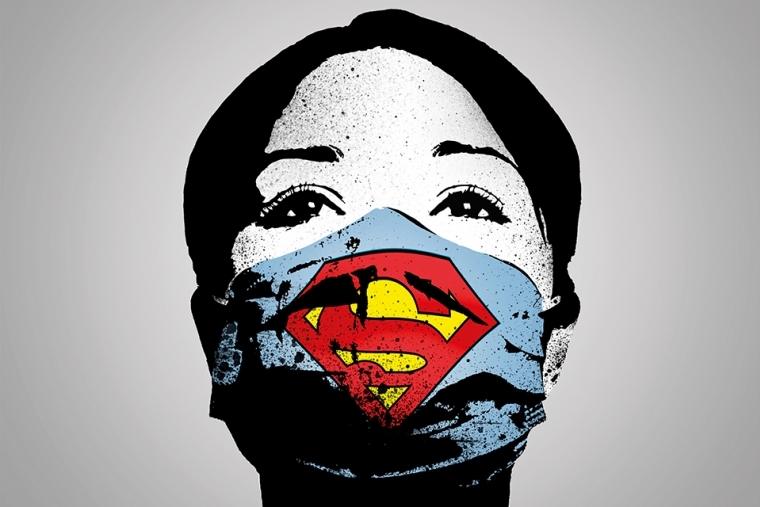
For the first time in the history of the Museum Administration Master of Arts (M.A.) degree program, St. John’s students curated an exhibit outside of the Dr. M. T. Geoffrey Yeh Art Gallery in a virtual gallery, custom-designed by students to display more than 30 pieces.
The new exhibit, “UNPRECEDENTED: Posters from a World on Pause,” showcases posters, gifs, and videos that focus on four themes related to COVID-19 response and social change. Ironically, with large public gatherings paused throughout the country, it was the subject matter of the exhibit itself that necessitated the move to a virtual space.
“Working with the technology of an online exhibition platform was a challenge at first, but the shift from exhibiting in the brick-and-mortar Yeh Gallery brought many pedagogical advantages,” explained Susan Rosenberg, Ph.D., Director, M.A. program in Museum Administration, and Professor of Art History, St. John’s College of Liberal Arts and Sciences. “Students designed and worked with a virtual model in the midst of the class, which replicates the experience of curating. They just jumped into the experience and rose to the challenge together.”
Beginning in September 2020, the four student curators, Taylor Lyons, Madeleine Schulz, Stephanie Zambrana, and Mengke Zhang, researched and organized the exhibition around COVID-19 and social justice themes, with content made available by the activist organization Amplifier Foundation and by the United Nations, in partnership with the art networking website, Talenthouse.
One goal of the virtual exhibit is to faithfully emulate the experience of a true brick-and-mortar gallery, something that the group accomplished by treating the virtual installation of the exhibit the same way they would have in a physical space.
“The early challenge was trying to imagine seeing everything in front of you in a physical space,” said Stephanie. “It was hard to imagine how everything would look in the exhibit. Different layouts affected how the works of art looked together, and there needed to be a flowing narrative throughout the exhibit.”
“We wanted to make it an interactive and immersive experience—not something where people just scrolled through some images,” explained Taylor. “The idea was to take people out of their world and into the exhibit.”
Working in a virtual space has some unexpected benefits. “We didn’t have to worry about things like natural light versus artificial lighting,” said Mengke. “It was also easier to move images around—and you did not have to worry about damaging a poster.”
One exhibit theme, “Social Justice Amidst a Pandemic,” features works from all corners of the globe, including Australia, China, Costa Rica, Germany, Scotland, and the United States, each addressing the pandemic through the filter of social justice.
The images within the theme “Borderless Hygiene” focus on the simple act of washing hands. “Wash Your Hands for at Least 20 Seconds,” a neon window sign in GIF form, features bubbles surrounding two hands washing. The bubbles in the GIF blink on and off until adjacent red bars in the image count to 20.
“Pandemic Heroes” features one of Madeleine’s favorite exhibit pieces, a poster titled “Super Nurse,” which depicts a nurse wearing a protective mask that features a familiar comic book symbol—the iconic Superman “S.”
“What We Owe Each Other” includes four posters that advocate for safe working conditions, personal protective equipment, emotional support, and the well-being of frontline workers.
Another challenge for students in the cohort was curating an exhibit on a historic event while it was still happening. “The classic curator is a scholar who already has expertise in something,” explained Mengke. “In our experience, we were learning about the subject matter as we were reviewing the show.”
Taylor had similar feelings. “It was difficult to provide context in a time when things are still changing every day,” he said. “What’s wonderful about the exhibit is that over time, the content of the themes within the exhibit changed based on events that were taking place in the world.”
The experience of curating a virtual exhibit provided the students with a unique opportunity to collaborate on a complex project where every component needed to complement the others.
“It was interesting to learn about the curatorial choices my classmates made and how that affected my own decisions,” said Stephanie. “You have to act like a hive mind in some ways.” Taylor agreed with that notion. “We have all worked on group projects before, but the engagement level here was much higher,” said Taylor. “There was a level of responsibility that I hadn’t quite felt before.”